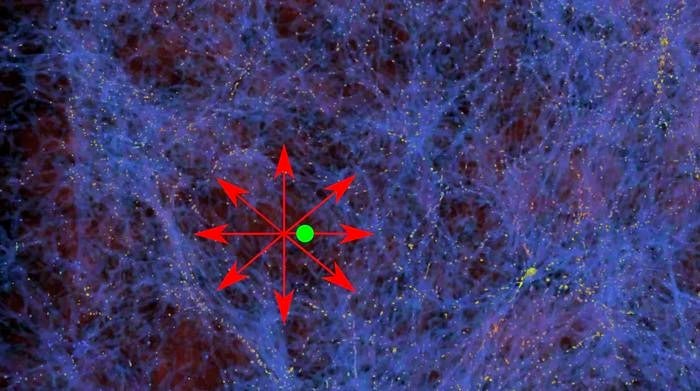
Astronomers have proposed a new way to solve the so-called “Hubble tension,” but the approach ultimately raises more questions than it answers.
By way of background, cosmologists are in a bit of a crisis these days. One of the most important numbers they can measure is the so-called Hubble constant, the rate of expansion of the present-day universe. At their disposal cosmologists have two sets of tools to measure this number. On one side are tools that probe the relatively nearby universe, like measuring the brightnesses of a certain kind of exploding star known as Type 1a supernovae. These supernovae all erupt with the same absolute brightness, so by measuring their observed magnitudes, astronomers can calculate their distances, and then use that to estimate how quickly the universe is expanding.
The downside of this approach is that supernovae don’t always explode with exactly the same brightness, and for the kind of precision measurements astronomers are aiming for, they have to include assumptions and modeling of supernovae, which can potentially introduce inaccuracies.
A different approach sees astronomers turning to the very distant universe, especially the cosmic microwave background radiation, abbreviated as CMB. The CMB is the relic light leftover from when the universe was just 380,000 years old, and provides a detailed map of the cosmos at that epoch. Cosmologists can then use that measurement to calculate what the present-day Hubble constant ought to be. While subject to far less uncertainty than the supernova method, it does require the use of cosmological models.
These two approaches disagree with each other, hence producing the so-called Hubble tension. One way to solve the problem is to look for new physics that may explain the discrepancy.
Enter the ‘supervoid’
Some astronomers believe that Earth resides near the center of a “supervoid,” a large region of less-than-average density roughly 2 billion light-years in diameter. The presence of this supervoid would affect our measurements of the expansion rate, because galaxies within the supervoid generally flow outward toward the void’s edges. So when we go to measure how quickly the universe is expanding by looking at nearby supernovae, they get an extra “speed boost” because of this outward flow, which could possibly explain the tension. A team of researchers followed this line of thinking in a paper recently accepted for publication in the Monthly Notices of the Royal Astronomical Society.
But the existence of the supervoid itself may stretch the bounds of what our standard cosmological models can provide — it might just be too big. So to explain the existence of the supervoid, researchers have turned to MOND, short for Modified Newtonian Dynamics. This is an alternative hypothesis of gravity originally proposed to explain the behavior of galaxies without needing dark matter.
But MOND itself doesn’t do a good job of explaining the properties of the largest structures in the universe, and so the researchers had to add another ingredient: a new kind of particle known as a sterile neutrino. Essentially, sterile neutrinos are a different kind of dark matter that can work with MOND to explain large structures in the universe, like the local supervoid (which is ironic considering that the whole point of MOND was to get rid of the need for dark matter).
So by leaning on a giant supervoid in our local region of the universe, a new theory of gravity, and a new species of dark matter could enable researchers to resolve the Hubble tension and explain a relatively new result. This could show that galaxies in the local universe appear to be flowing away from us faster than they should in standard cosmological models.
Searching for simplicity
It’s an unproven but intriguing combination of thoughts. And we will likely have to add something to our understanding of the universe to eventually explain the Hubble tension. But it’s easy to add complexity to a model in order to achieve a desired result. And have that complexity add more headaches. In this case, the goal is solving the Hubble tension, and this model does so, at least in a preliminary fashion.
But it takes an awful lot of complexity to get there. Not all astronomers agree that the local supervoid exists; it’s tough to assess the overall density of the universe at these kinds of scales. Not all astronomers agree that the existence of the supervoid breaks our standard understanding of cosmology. It may be perfectly reasonable without leaning on “new physics.” Not all astronomers agree that the presence of a supervoid would distort our measurements of the Hubble constant. Supernovae may be largely unaffected. And few astronomers believe that MOND is a viable theory. In fact, the vast majority of astronomers and cosmologists don’t believe that MOND works at all, especially considering that it still requires introducing some form of dark matter to explain the variety of observed structures in the universe.
The sterile neutrino idea required to make this model work is purely hypothetical — an intriguing idea for sure, but not yet on solid ground. And lastly, for this model to work, the Milky Way would have to sit near the center of the local supervoid, not out near the edges, which is a difficult coincidence to include in any viable cosmological idea.
This research could lead somewhere fruitful, and possibly generate an interesting idea that could resolve the Hubble tension. Currently, the conclusions are based on relatively simple models of the growth of structures in the universe, and the next step will be to implement this idea in a more faithful simulation. And, ultimately, the evidence will decide the issue.









